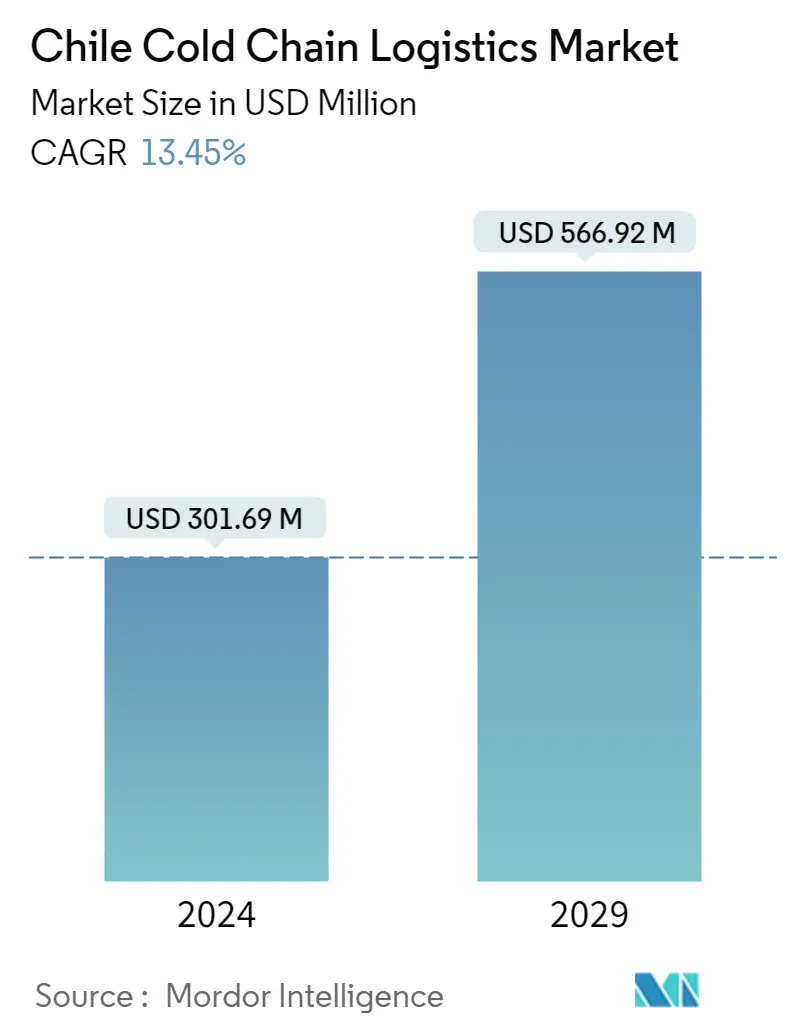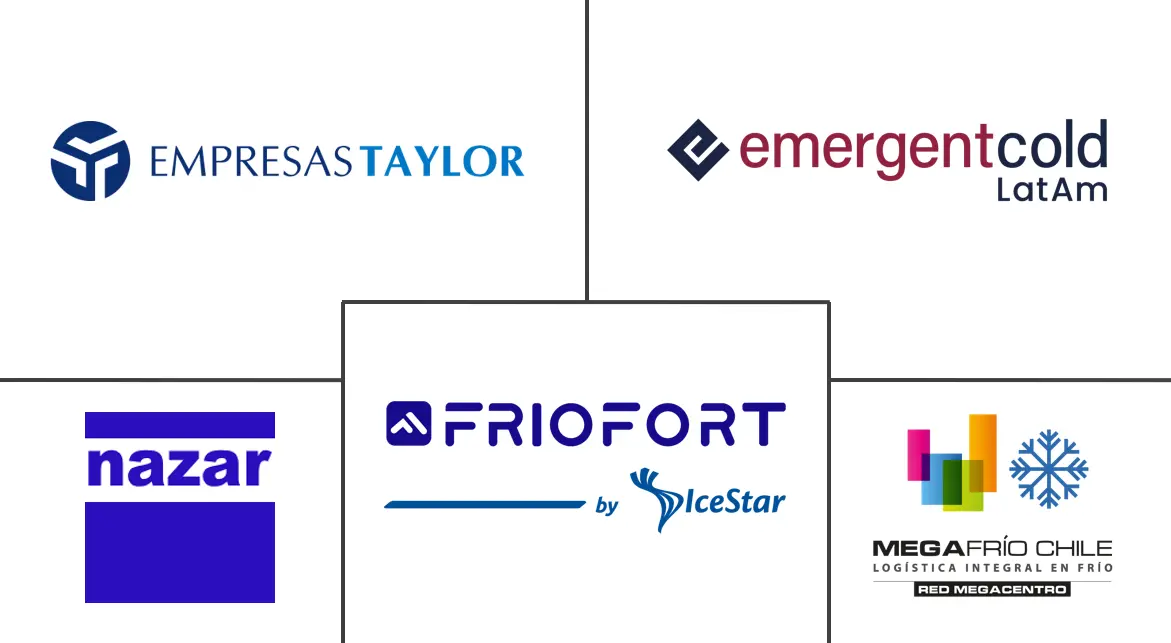Market Size of Chile Cold Chain Logistics Industry

| Study Period | 2020 - 2029 |
| Base Year For Estimation | 2023 |
| Market Size (2024) | USD 301.69 Million |
| Market Size (2029) | USD 566.92 Million |
| CAGR (2024 - 2029) | 13.45 % |
| Market Concentration | Low |
Major Players
*Disclaimer: Major Players sorted in no particular order |
Chile Cold Chain Logistics Market Analysis
The Chile Cold Chain Logistics Market size is estimated at USD 301.69 million in 2024, and is expected to reach USD 566.92 million by 2029, growing at a CAGR of 13.45% during the forecast period (2024-2029).
The increasing demand from the horticulture industry drives the market. Furthermore, the demand is driven by the country's growing e-commerce sector. Applicable data stresses the need for diligence to apply timely logistics and technological results for correct and effective operations that allow them to meet customers' requirements, whether they're companies or individuals, as vital to the business's substance. Thus, commerce, online companies, and retailers in general who want to carry out cross-border e-commerce operations and vend their products both inside and outside their borders bear mates who know the tricks of the different requests, the conditions of international trade and who offer comprehensive, scalable results acclimated to each country. They can also efficiently manage their force chain for further streamlined procedures and smoother service.
Most cherries are gathered and exported from Latin America. Chile is the most prominent patron, and China is the primary importer, entering over 85 of Chile's cherry exports. When exporting fresh fruits and vegetables similar to cherries, the main thing is for directors to secure the topmost value from their crop. This demands an end-to-end cold chain that handles the unique product conditions of the fruit and effectively works within the fruit's short crop season of late November to February. To ensure the most stylish possible cold chain service, Maersk developed a specific cold chain result acclimatized to the requirements of Chilean cherry directors – the Cherry Express service. The result is designed to expedite the transport of cherry exports. It's a wholly integrated, end-to-end logistics and transportation result that's presto, well-planned, and intended to deliver cherries to China and other global requests seamlessly. For the Chilean cherries, the cold chain starts in Teno, the core of Chile's cherry product region. The cherries are precisely handled as they move from vineyards to original quilting houses, where they're gutted, sorted, and packaged. Maersk reefers loaded with cherry boxes are hauled overland by road or rail to the San Antonio harborage and loaded onto an Ocean Cherry Express vessel. The conveyance is only 21 days to China – the fastest in the assiduity – with zero divagation in ETA. The Fresh Pass platoon precisely pre-planned each link in the cold chain to ensure a flawless end-to-end trip. This specialized Maersk service for reefer guests features expert vessel logistics collaboration, including booking and attestation for all parties to a perishable’s payload.
Chile Cold Chain Logistics Industry Segmentation
The technology and mechanism that allows for the secure delivery of temperature-sensitive goods and items along the supply chain are known as cold chain logistics. Any product that is perishable or is branded as such would almost certainly need cold chain management. A complete background analysis of Chile's cold chain logistics market, including the assessment of the economy and contribution of sectors in the economy, a market overview, market size estimation for key segments, emerging trends in the market segments, market dynamics and geographical trends, and COVID-19 impact, is covered in the report.
Chile's cold chain logistics market is segmented by service (storage, transportation, and value-added services), temperature type (chilled, frozen, and ambient), and end-user (horticulture ((fresh fruits and vegetables), dairy products (milk, ice cream, butter, etc.); meat, fish, and poultry; processed food products; pharma, life sciences, chemicals; and other end users). The report offers market size and forecasts for all the above segments in value (USD).
| Service | |
| Storage | |
| Transportation | |
| Value-added Services (Blast Freezing, Labeling, Inventory Management, etc.) |
| Temperature | |
| Chilled | |
| Frozen | |
| Ambient |
| End User | |
| Horticulture (Fresh Fruits and Vegetables) | |
| Dairy Products (Milk, Ice Cream, Butter, etc.) | |
| Meat, Fish, and Poultry | |
| Processed Food Products | |
| Pharma, Life Sciences, and Chemicals | |
| Other End Users |
Chile Cold Chain Logistics Market Size Summary
The Chilean cold chain logistics market is poised for significant growth, driven by increasing demand from the horticulture and e-commerce sectors. The market's expansion is supported by the country's strategic position in the export of fresh produce, particularly cherries, which require meticulous cold chain management to maintain quality during transit. Companies like Maersk have developed specialized services, such as the Cherry Express, to streamline the export process, ensuring rapid and efficient delivery to international markets, particularly China. The integration of advanced logistics and technology solutions is crucial for meeting the diverse needs of businesses engaged in cross-border e-commerce, enabling them to navigate the complexities of international trade and optimize their supply chain operations.
Chile's retail landscape is characterized by a robust presence of domestic retailers and a thriving food processing sector, with significant contributions from major players like Walmart, Cencosud, and Falabella. The country's extensive network of free trade agreements facilitates access to global markets, keeping import costs low and fostering competition. The COVID-19 pandemic has accelerated the digital transformation of retail operations, prompting enhancements in logistics capabilities and digital presence. The cold chain logistics market in Chile is fragmented, with both global and local entities playing pivotal roles. Recent acquisitions by companies like Emergent Cold Latin America highlight the ongoing consolidation and expansion efforts within the sector, aiming to enhance capacity and service offerings to meet the growing demands of the market.
Chile Cold Chain Logistics Market Size - Table of Contents
-
1. MARKET INSIGHTS
-
1.1 Current Market Scenario
-
1.2 Market Dynamics
-
1.2.1 Drivers
-
1.2.1.1 Growing Fruit Exports
-
-
1.2.2 Restraints
-
1.2.2.1 Challenges of First Mile Distribution in Chile
-
-
1.2.3 Opportunities
-
1.2.3.1 Increasing Frozen Food Popularity
-
-
-
1.3 Technological Trends and Automation
-
1.4 Government Regulations and Initiatives
-
1.5 Industry Value Chain/Supply Chain Analysis
-
1.6 Spotlight on Ambient/Temperature-controlled Storage
-
1.7 Industry Attractiveness - Porter's Five Forces Analysis
-
1.7.1 Bargaining Power of Suppliers
-
1.7.2 Bargaining Power of Buyers/Consumers
-
1.7.3 Threat of New Entrants
-
1.7.4 Threat of Substitute Products
-
1.7.5 Intensity of Competitive Rivalry
-
-
1.8 Impact of Emission Standards and Regulations on the Cold Chain Industry
-
1.9 Impact of the COVID-19 Pandemic on the Market
-
-
2. MARKET SEGMENTATION
-
2.1 Service
-
2.1.1 Storage
-
2.1.2 Transportation
-
2.1.3 Value-added Services (Blast Freezing, Labeling, Inventory Management, etc.)
-
-
2.2 Temperature
-
2.2.1 Chilled
-
2.2.2 Frozen
-
2.2.3 Ambient
-
-
2.3 End User
-
2.3.1 Horticulture (Fresh Fruits and Vegetables)
-
2.3.2 Dairy Products (Milk, Ice Cream, Butter, etc.)
-
2.3.3 Meat, Fish, and Poultry
-
2.3.4 Processed Food Products
-
2.3.5 Pharma, Life Sciences, and Chemicals
-
2.3.6 Other End Users
-
-
Chile Cold Chain Logistics Market Size FAQs
How big is the Chile Cold Chain Logistics Market?
The Chile Cold Chain Logistics Market size is expected to reach USD 301.69 million in 2024 and grow at a CAGR of 13.45% to reach USD 566.92 million by 2029.
What is the current Chile Cold Chain Logistics Market size?
In 2024, the Chile Cold Chain Logistics Market size is expected to reach USD 301.69 million.

